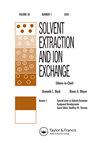Solvent Extraction and Complexation Studies of Pyridine-di-Phosphonates with Lanthanides(III) in Solutions
IF 2.1
4区 化学
Q3 CHEMISTRY, MULTIDISCIPLINARY
引用次数: 0
Abstract
ABSTRACT In this work, we studied the complex formation (1H, 31P NMR-titration, UV–vis titration, luminescent titration) and solvent extraction of lanthanides with pyridine diphosphonates. The stoichiometry of the complexes was determined: ML and ML2 forms are present. This is confirmed by all of the above methods. It was found that the pyridine ring and P=O groups are involved in the coordination of the metal cation. The coordination environment of the Eu(III) cation was studied more thoroughly using the EXAFS method in solution. Coordination numbers and distances were determined for the complex in solution. The influence of the lanthanide radius on the value of the stability constant was shown. The change in extraction efficiency in the series of lanthanide is described. A new pattern, unusual for other phosphorus-containing ligands, was obtained. To explain the change in the parameters of complexation depending on the system, DFT calculations were carried out. The effect of various initial states of the extracted cations was shown. The initial state with a large amount of nitrates corresponds to a two-phase system during extraction, and with a smaller amount, to a single-phase system with acetonitrile. Additionally, the luminescent properties of the complexes were described in detail as one more applied aspect of the work. . GRAPHICAL ABSTRACT吡啶二膦酸盐与镧系元素(III)溶液的溶剂萃取及络合研究
摘要在这项工作中,我们研究了镧系元素与吡啶二膦酸盐的络合物形成(1H,31P NMR滴定,UV–vis滴定,发光滴定)和溶剂萃取。确定了配合物的化学计量:存在ML和ML2形式。以上所有方法都证实了这一点。发现吡啶环和P=O基团参与了金属阳离子的配位。用EXAFS方法对溶液中Eu(III)阳离子的配位环境进行了较为深入的研究。为溶液中的复合体确定了配位数和距离。研究了镧系元素半径对稳定常数的影响。描述了镧系元素萃取效率的变化。获得了一种新的模式,这对于其他含磷配体来说是不寻常的。为了解释络合参数随体系的变化,进行了DFT计算。显示了提取的阳离子的各种初始状态的影响。含有大量硝酸盐的初始状态对应于萃取过程中的两相系统,而含有少量硝酸盐的起始状态对应于含有乙腈的单相系统。此外,作为工作的另一个应用方面,详细描述了配合物的发光特性。 . 图形摘要
本文章由计算机程序翻译,如有差异,请以英文原文为准。
求助全文
约1分钟内获得全文
求助全文
来源期刊
CiteScore
4.40
自引率
5.00%
发文量
15
审稿时长
8.4 months
期刊介绍:
Solvent Extraction and Ion Exchange is an international journal that publishes original research papers, reviews, and notes that address all aspects of solvent extraction, ion exchange, and closely related methods involving, for example, liquid membranes, extraction chromatography, supercritical fluids, ionic liquids, microfluidics, and adsorption. We welcome submissions that look at: The underlying principles in solvent extraction and ion exchange; Solvent extraction and ion exchange process development; New materials or reagents, their syntheses and properties; Computational methods of molecular design and simulation; Advances in equipment, fluid dynamics, and engineering; Interfacial phenomena, kinetics, and coalescence; Spectroscopic and diffraction analysis of structure and dynamics; Host-guest chemistry, ion receptors, and molecular recognition.

 求助内容:
求助内容: 应助结果提醒方式:
应助结果提醒方式:


